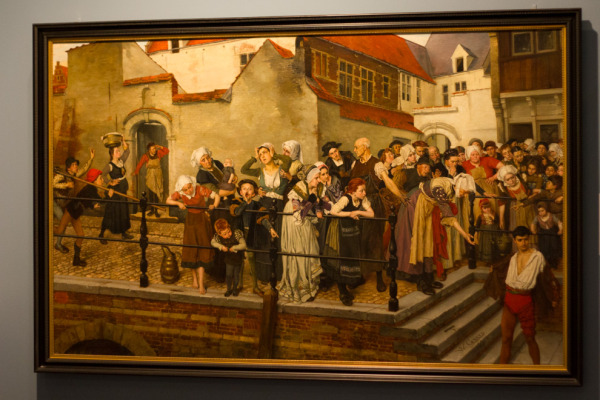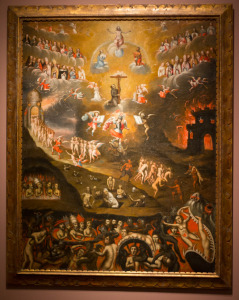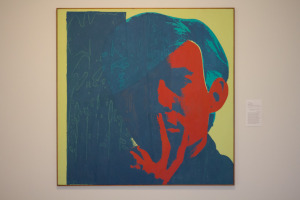Since opening in 1894, the Cantor Center for Visual Arts has expanded its collection to encompass a vast breadth of artwork. A blend of the classic and the contemporary, the collection ranges from postmodern American to antiquated ethnic pieces. Here’s a rundown of five must-see works—across various cultures and movements—to catch on your next visit to Cantor.
1. “The Accident” by William Geets

This painting by neoclassical Belgian painter Willem Geets captivates with its European aesthetic. As a neoclassical painter, Geets contributed to an art movement that sought to revive the art style from Greece and Rome of antiquity. Framed with a fantastic selection of earthy and warm colors, the piece is incredibly expressive. Raw emotion is etched into the face of each bystander in the crowd, evidenced in the children’s overtly puzzled expressions and the exasperated cries of open-mouthed, infant-coddling housewives. The spectators’ fixed gazes and pointing fingers pull the viewer’s gaze across the surface of the painting, towards the titular hero at the bottom-right of the piece.
2. “Blue Clamp” by Jim Dine

“Blue Clamp” is a classic example of American pop artist Jim Dine’s affinity for found objects as motifs in his work, best described as hybrids of paintings and sculptures. The work features a heart dripped onto a canvas, with a single blue clamp jutting conspicuously outward from the center. Complementary reds, greens, violets and yellows create a visceral, rustic tone. Gobs of paint give the canvas a visible topography, accentuating the rawness of the piece while offering insight into Dine’s creative process. The piece captures the essence of the pop art movement because it so clearly deviates from the conventions of sculpting and painting, choosing instead to blur the line between the two mediums.
3. “Last Judgment” by Pieter I de Jode

“The Last Judgement” by Pieter I de Jode . Photo by Avi Bagla.
As an original print of a late 16th century altarpiece, Pieter I de Jode’s “Last Judgment” commands attention with its needle-sharp line quality and powerful religious undertones. Visibly partitioned into nine sections, the presentation of the piece is reminiscent of a paned window and similar to the panels of a modern comic. Upon closer inspection, the sheer intricacy of the piece becomes apparent. In the upper half of the piece, a vortex of clouds encircles angels who are carrying horns and peering down at a slew of demonic creatures running amok. The murky ambiance of the Ruth Levison Halperin Gallery complements the tension in the piece, which is both brutal and provocative.
4. “Mao” by Andy Warhol

Andy Warhol’s silkscreen of Chairman Mao, a controversial Chinese Communist leader, is one of the American artist’s most recognizable pieces. Warhol’s portraits of pop culture icons, executed in his signature hard-edged style, propelled him to the forefront of the pop art movement in the mid-1900s. His palette, consisting of garish primary and secondary colors, has somewhat of a dehumanizing effect on the piece. Indeed, Warhol himself expressed an interest in making his artwork anonymous and noncommittal. Texture is minimal, bar a few seemingly arbitrary scribbles and imperfections in the screenprint that together give an impression of defilement. Although the piece is striking, the message it conveys is not immediately evident.
5. “The Thinker” by Auguste Rodin

The Cantor Arts Center is home to one of just 12 bronze casts of Auguste Rodin’s sculpture, “The Thinker,” in North America. Originally meant as a likeness of Dante, the sculpture has been heralded as one of the most recognizable in history – it’s one of Rodin’s most iconic pieces. As the centerpiece of Cantor’s Rodin collection – the largest outside of France – “The Thinker” rests ominously between columns of marble, with light falling gently upon its smooth complexion. This exhibition is not just the flagship of Iris and B. Gerald Cantor’s collection, but it’s also an ode to one of the fathers of modern sculpture. Hat’s off to you, Rodin.
The Cantor Arts Center is opened six days a week from Wednesdays to Mondays and offers free admission for all.
Contact Eric Huang at eyhuang ‘at’ stanford.edu.
